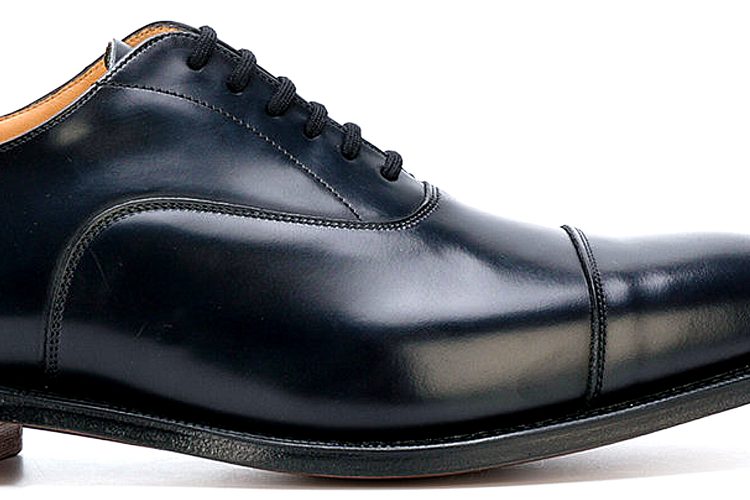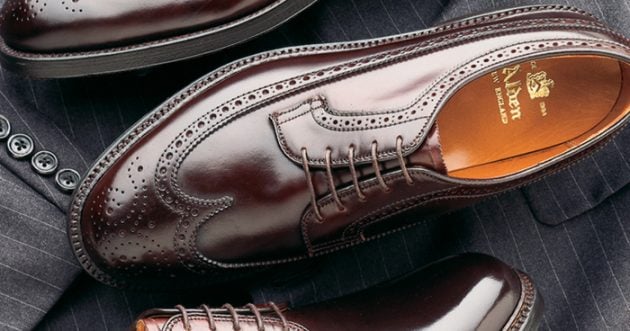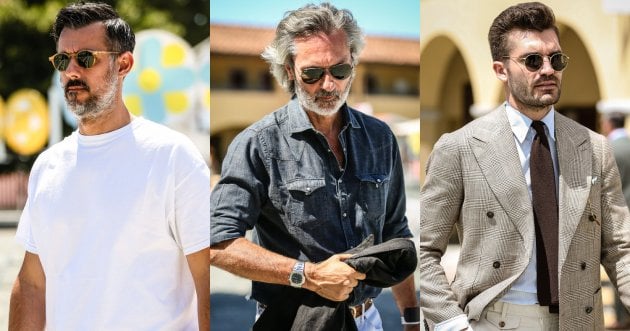
Chelsea” is Edward Green’s signature straight-tip shoe with an inside shuttlecock. The brand, which boasts one of the best technologies and popularity in the leather shoe industry, has been working on these shoes, and it would not be an exaggeration to say that they are the “pinnacle of straight tips with inside blades”. This time, we focus on the “Edward Green Chelsea” and introduce its charms!
Suponsered by
What is Edward Green?
Edward Green was founded in 1890 by a shoemaker of the same name, who began making dress shoes for gentlemen in a small factory in Northampton. No one in shoemaking has ever pursued such delicate techniques and beauty as Edward Green, and he quickly gained fame as “one of Britain’s rare and brilliant shoemakers” and became a favorite in many countries around the world. There are many prestigious British leather shoe manufacturers such as ” John Robb” and “Church. While most of them are under the umbrella of major fashion brands, Edward Green is a rare shoemaker that has overcome several financial difficulties and is still active as an independent brand.” Since its founding, Edward Greene has continued to produce beautiful dress shoes that make full use of its advanced technology and masterpiece lasts based on its belief of “seeking the highest possible quality.
What is Chelsea, the “pinnacle of the straight tip with an inside shuttlecock”?
The Chelsea is one of Edward Green’s most popular “inside straight tip” leather shoes. Also called “cap toe (oxford)” because of its design that looks like a cap on the toe, this shoe is positioned as the most formal of all leather shoes. They can be used for business as well as weddings and funerals, making them an indispensable item for all adult men. Because they are less decorative than brogue shoes, people tend to think that it is difficult to tell the difference in design and quality between straight tip shoes with inner wings and brogue shoes. However, no other straight tip with an inside shuttlecock has as much to say as Edward Green’s Chelsea. The quality of the leather, of course, but also the iconic swan neck and sophisticated silhouette. It is precisely because the Chelsea is a straight tip with an inside shuttlecock that has little ornamentation that makes it seem like a ready-to-wear shoe, that the Chelsea is truly “exceptional.
Edward Green Chelsea Leather
There are many points that determine the quality of leather shoes, but there is no other factor that makes the biggest difference in the impression on the outside than “leather quality. For example, the original manufacturing method and high level of detailed sewing technology may be appreciated by experts, but it is also true that it is difficult for people who are not interested in leather shoes to understand the value of such things. However, the difference between “good leather” and “cheap leather” can be felt even if one does not have a deep knowledge of leather shoes. Edward Green, which boasts the best tradition among British shoemakers, is known for using the highest quality calfskin.
Good leather shoes are characterized by the gradual “bottom glow” from each and every tissue, cell, and fiber of the leather. On the other hand, mass-produced cheap leather shoes, even if they claim to be made of genuine leather, have a somewhat less dignified, superficial luster. Of course, the difference is obvious when it comes to the absorption of shoe cream and the change in leather quality after years of use. Chelsea’s leathers show that the philosophy of the company’s founder, Edward Greene, of “seeking the best possible quality” has been passed down to the present day. Even people who are not interested in leather shoes can tell at a glance that Chelsea shoes are “luxury shoes,” and of course, the quality of Chelsea shoes will make even leather shoe lovers groan.
Edward Green Chelsea’s iconic “Swan Neck” design
If the appeal of the Chelsea is that its “leather quality” is universally recognized, the “swan neck” is an iconic design that instantly identifies it as “Edward Green’s Chelsea. In the straight tip with inner wings, there are stitches on the left and right sides of the lace stays and at the dove’s eye area. These stitches are generally stitched in a gentle arc parallel to the shoe lace holes.
The swan neck, as the name implies, is a design in which the stitching is curved at an acute angle, like a “swan’s neck. This detail itself has existed since ancient times, when boots were still the mainstream of men’s shoes. Edward Green was the first brand to adopt the swan neck for short dress shoes.
The Swan Neck was born as a result of a takeover attempt by Hermes. Edward Green had been on the verge of financial crisis several times in its long history, but in this turmoil that occurred in the late 1990s, the company gave up the factory it had operated since its establishment, as well as all the wooden patterns and paper patterns it had preserved. The brand itself somehow managed to survive, and later achieved a miraculous revival with the development of new lasts and a renewal of designs. At this time, the swan neck was adopted for Chelsea and other oxford shoes. The swan neck, which had never existed in straight tips with inside wings before, gradually spread as a design representative of the classic style. Eventually, other brands adopted the swan neck, but the fine leather quality and fine stitching made it easy to tell whether the shoe was a Chelsea shoe or simply an imitation of the design. The swan neck is a Chelsea design. The swan neck is a detail that symbolizes Chelsea, and it is also the “pride” of Edward Green, which has risen like a phoenix from the brink of extinction.
Chelsea’s Double Stitching that will make even the “experts” swoon.
The “cap” at the toe is the most distinctive feature of the formal straight tip with an inside shuttlecock, which has almost no ornamentation. The single letter of this cap is drawn with two stitches, which is an orthodox straight tip. The narrower the distance between the two stitches, the higher the level of skill. Although it is a point that cannot be seen without close inspection, the stitching on the Chelsea shows how Edward Green pursues quality down to the smallest detail. The double stitching without any irregularities is the best proof of the brand’s high sewing technology.
The Edward Green Chelsea is beautiful from any angle.
The Chelsea, no matter what angle you look at it from, you will not feel any signs of squeamishness. Of course, the impression varies depending on the lasts used, but no matter which lasts are used, this model is full of high “elegance. The beautiful shape of Edward Green shoes is said to have been inspired by the “Porsche 911. Like the famous car that fascinated people with its sophisticated form, the Chelsea is impeccable from any 360° angle.
Edward Green Chelsea heel cup
Regardless of the last used, the Chelsea is characterized by its small heel cup. This makes it easy to fit the Japanese foot, which has a small heel, and provides an excellent sense of hold. Since the opening is also set slightly low, there is little worry of damaging the ankles even after the wearer has become accustomed to wearing the shoe and the inside has sunk in. The heel cup outline also creates a sleek silhouette.
Chelsea’s high-level Goodyear welt method
The sole of the Chelsea is made by the Goodyear welt method, which is the royal road of English shoes. The upper, insole, and welt are joined together with a rake stitch, and then the outsole and welt are joined together to increase durability and sturdiness. The Goodyear welt method has many other advantages, such as the fact that all soles can be replaced, but the most wonderful of all is that the more a pair is worn, the more it adapts to the foot. As the shoes are worn several times, the cork inside sinks in and conforms to the shape of the owner’s feet. Because the cork also serves as a cushion, the shoes are more comfortable than those made by other methods and are suitable for walking for long periods of time. The Goodyear welt method also has an external characteristic in that the “cork” of the sole protrudes. Chelsea’s soles are very carefully finished, and this neatness and beauty is a result of the skill of our skilled craftsmen.
Edward Green Chelsea insole & lining
The quality of Edward Green is not only in the beauty of the shoes when worn, but also in the pursuit of attention to detail in areas only the owner can see. The brand name is embossed on the insole. The lining has a window in which the lasts and sizes used are handwritten. Of course, both the insole and lining are made of the finest leather. All parts are made of materials that can withstand years of use.
Edward Green Chelsea outsole & heel
Goodyear welted leather shoes, in which the outsole is stitched on, normally show “seams” when looking at the sole of the shoe. However, Chelsea uses a finishing technique called “Hidden Channel” for the outsole. This technique, in which the outsole is excavated, grooved, and sewn before the leather is laid down, requires advanced craftsmanship and is used only for high-end shoes. The beauty of the craft-like chesnut antique color is so beautiful that it makes one hesitate to walk on asphalt.
The company’s commitment to not skimping even on the parts that are not visible is also reflected in its heels. The traditional manufacturing method is stubbornly followed, and the heels are attached through a two-step process. The company’s attitude of continuing to uphold tradition by putting as much effort as possible into the work is something to be admired.
Incidentally, the triple nailing on the heel is also a specification unique to Edward Green.
Chelsea’s beautiful silhouette varies with the last
Edward Green’s classic form last “#202
The traditional last, “#202,” embodies the refined style of shoe designer John Hulstick, who symbolizes the traditional English shoe. Later, it was remade into the current new 202 last due to the takeover frenzy that occurred in the mid-1990s. The ball joint has a roomy feature that makes it easy to fit the width of Japanese people’s feet, and the foot is firmly supported by squeezing the ball of the foot. The classic silhouette still has many deep-rooted fans due to the slightly plumped-up form from the instep to the ball joint and the small “cap.
For details and purchase, click here.Edward Green’s #82 last, the most balanced last
The “#82,” introduced in 2003, inherited the characteristics of the “#202,” but with a modern sensibility. Compared to the #202, the Last 82 has a sharper look and a more curved silhouette from the joint line to the toe. The nose is longer, and the round toe is slightly pointed for a modern look. The silhouette is suitable for everyone, keeping the orthodox form of English dress shoes while also keeping with the trends of the times. 164,160 yen (tax included )
Click here for details and purchaseEdward Green’s sharp and modern long-nose last “#915
The “#915” last was released in 2015. The toe of the “#82” is extended a few millimeters, and the nose is further elongated, while the outside of the toe has an edge. It is even sharper than the “#82” and is a well-balanced modern update. In contrast to the rounded form of the “#202,” the “#82” does not look overdone, but this is because Edward Green respects tradition and follows the lasts of the past. The stylish impression is reminiscent of a bispoke shoe. 176,040 yen (tax included)
Click here for details and to purchase

























![Leather Shoes for Men [ Brands for Adults by Country ].](https://otokomaeken.com/wp-content/uploads/2015/09/ae46b1f460ee46f789c27b264a6cb421-630x331.jpg)





![Special feature on dress shoes by price [ Selected lifetime items priced at 100,000 yen or more ].](https://otokomaeken.com/wp-content/uploads/2017/09/3d94c0146156fcb1049939849487c91d-630x331.jpg)


















